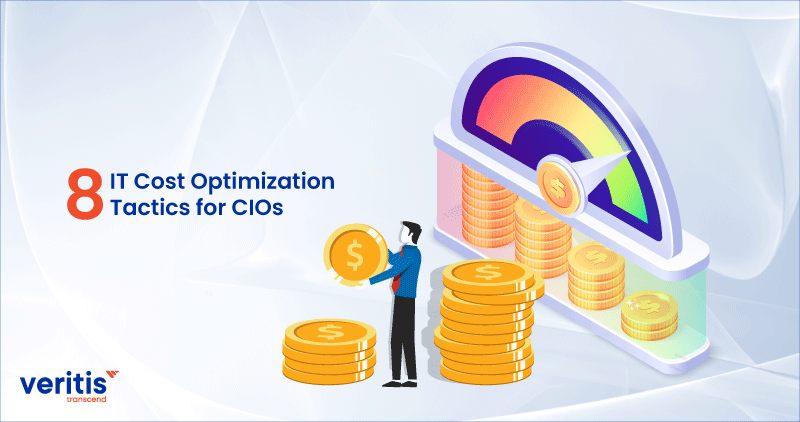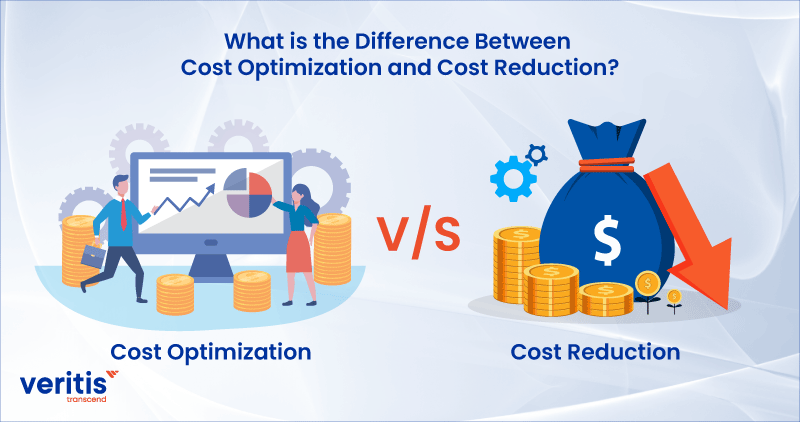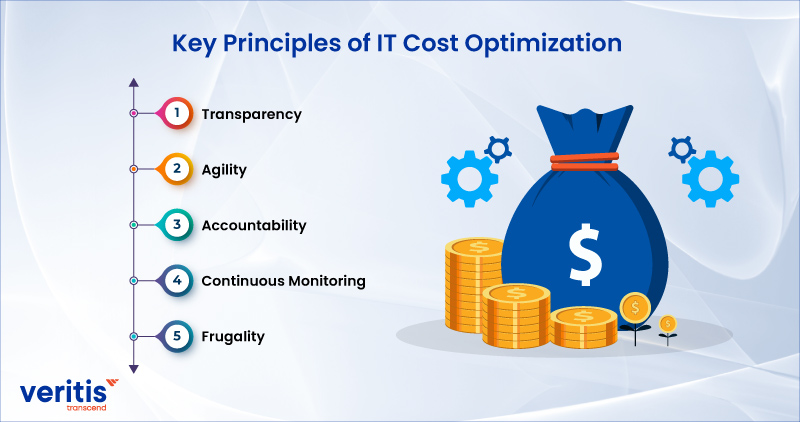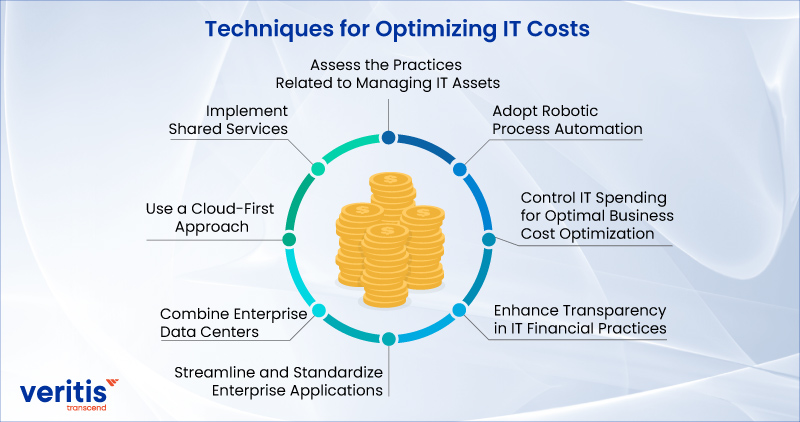
When a business executive asks Chief Information Officer (CIO) to lower expenses, they work together to assess their spending on information technology (IT) and the factors that drive costs. They analyze how these IT expenses affect the provision of IT services and their impact on business costs and revenue. However, they unintentionally overlook evaluating how these costs affect other departments.
Technology is crucial for driving growth and achieving success in today’s fast-moving business environment. However, keeping up with and improving technology can be costly for many companies. Optimizing IT costs has become a major focus for companies facing budget limitations. In contrast, we are striving to stay technologically updated and competitive.
CIOs should establish a proactive culture of IT cost optimization. This will help strengthen their position with the CEO and stakeholders in the organization. CIOs need to demonstrate that they have a proactive plan for consistently optimizing costs. This will help them show evidence of their strategy to the CEO and stakeholders.
CIOs should communicate their plan for reducing IT costs to non-IT decision-makers. They can achieve this by showcasing evidence of their proactive strategy for ongoing cost optimization. You can achieve this by adjusting steps based on the business’s and stakeholders’ priorities.
What is Cost Optimization?
Cost optimization is an ongoing effort to reduce unnecessary spending, unused resources, or investments that don’t bring much value to the IT budget. The goal is to lower IT costs while using the saved money to invest in new technology, which helps businesses grow faster or make more profits.
Cost optimization aims to provide the best possible customer experience while keeping costs at the right level. According to Amazon Web Services, AWS cost optimization means using all resources efficiently to achieve desired results while keeping costs as low as possible. It also involves continuously improving and fine-tuning workloads to save money and get better returns.
The AWS cost optimization pillar focuses on creating and managing workloads mindful of costs. This means designing and operating systems that help you achieve your business goals while minimizing expenses and maximizing your organization’s return on investment. According to Microsoft Azure, cloud optimization cuts unnecessary expenses and makes operations more efficient.
AWS Cost optimization is a way to lower expenses and increase the worth of a business. It involves finding ways to spend less money while making the business more valuable.
- Getting the best price for the things a business purchases
- Making cost calculations simpler and using consistent methods for technology related to costs
- Using technology to automate and make digital IT and business tasks to save money throughout the organization
AWS Cost Optimization Best Practices
To optimize AWS cost optimization, follow these three AWS cost optimization best practices:
- Leverage AWS cost optimization explorer to analyze usage patterns and identify cost-saving opportunities.
- Use AWS reserved instances and savings plans for discounted pricing on long-term commitments.
- Implement automation and monitoring through AWS trusted advisor and cost and usage reports to identify idle resources and right-size your infrastructure.
Remember, AWS cost optimization best practices are an ongoing process. Monitor, analyze, and optimize your AWS resources to maximize cost savings and efficiency.
Useful link: Cloud Cost Optimization and Management: Trends, Analysis and Strategy!
What is the Difference Between Cost Optimization and Cost Reduction?

Cost optimization and cost reduction are important concepts for businesses that want to save money. However, there are some key differences between the two.
Cost reduction is a short-term approach to cutting costs. It typically involves identifying areas where expenses can be trimmed, such as laying off employees, reducing travel expenses, or cutting back on marketing spending. Cost reduction can be a quick way to save money, but it can also have negative consequences, such as decreased productivity, customer dissatisfaction, or even lost market share.
Cost optimization is a more long-term approach to managing costs. It involves identifying and eliminating unnecessary costs while ensuring the business can meet its goals. Cloud cost optimization can involve various activities, such as negotiating better contracts with suppliers, streamlining processes, and investing in new technologies. Cloud cost optimization can take more time and effort than cost reduction, but it can lead to more sustainable savings.
The key differences between cost optimization and cost reduction:
| Cost Optimization | Cost Reduction |
| A long-term approach to managing costs | A short-term approach to cutting costs |
| Aims to eliminate unnecessary costs while still meeting business goals | Aims to reduce costs by any means necessary |
| This can lead to more sustainable savings | It can have negative consequences for the business |
| It takes more time and effort | It can be implemented quickly |
In general, cloud cost optimization is a more sustainable and effective way to save money than cost reduction. However, cost reduction can be a necessary short-term measure in some cases. The best approach for a particular business will depend on its specific circumstances.
Examples of cost optimization:
- Negotiating better contracts with suppliers
- Streamlining business processes
- Investing in new technologies that can help to reduce costs
- Reorganizing the workforce to improve efficiency
- Eliminating unnecessary expenses, such as travel costs or marketing spend
Examples of cost reduction:
- Laying off employees
- Reducing travel expenses
- Cutting back on marketing spend
- Canceling subscriptions or memberships
- Deferring non-essential projects
Useful link: The 5-Step Strategy to Manage and Optimize Public Cloud Costs
Key Principles of IT Cost Optimization

1) Transparency
Clear visibility into IT operations and costs is crucial for making informed investment decisions and optimizing business outcomes. Before this can happen, IT and the business must agree on the value of IT projects and what they expect from IT. However, basic cloud cost optimization tools often lack the necessary information to estimate resource usage and understand the business impact.
Transparency allows for different perspectives on IT spending, leading to better prioritization and consensus on cloud optimization opportunities. Without transparency, doubts can arise about the value of previous IT investments, undermining enterprise stakeholders’ confidence. On the other hand, transparency brings additional benefits such as improved demand management, identification of business value, treating IT as a business, accurate estimation capabilities, and demonstrating the value of IT. This enables the IT organization to play a more strategic role in the business and engage in discussions that balance costs with IT benefits.
2) Agility
Companies must be adaptable to their goals and external conditions to optimize continuously. Optimizing IT costs isn’t just about reducing costs but finding a balance between lower costs and flexible sourcing. This flexibility allows companies to adjust resources and costs in response to internal and external changes.
A common issue arises when a company successfully reduces costs, but most expenses are tied to fixed, long-term contracts with vendors and service providers. This means they can only easily cut costs if the demand for IT decreases by paying hefty penalties to terminate those contracts. It also limits their ability to increase capacity when needed. To address this, sourcing IT on a variable basis can provide a solid foundation for ongoing cloud cost optimization tools.
To optimize effectively, firms should embrace agility as a core principle. This involves evaluating initiatives and prioritizing cost-effective options. After implementation, the focus shifts to demand cloud cost management, ensuring the business consumes IT resources wisely and offering optimized consumption options.
3) Accountability
Achieving full optimization in IT requires evaluating both the supply and demand sides. Many organizations focus only on supplying IT to meet business needs, which can lead to a reactive approach. To ensure continual cloud cost optimization tools, leaders must take ownership of their business investments and actively engage with the business to manage capacity, features, and functions provided by IT.
4) Continuous Monitoring
The main difference between IT cost-cutting and cost optimization strategies is that cost-cutting requires a one-time effort, while cost optimization involves an ongoing process. When an organization aims to reduce expenses strategically, it must also commit to regularly monitoring performance to prevent the accumulation of waste again. Effective cloud cost management is crucial for achieving sustainable cost optimization.
To stay on track, reviewing expenses, gathering reports, and analyzing data regularly are important. This allows you to identify any unusual spending patterns and take corrective action before they spread throughout the company.
Furthermore, implementing control measures is essential to maintain adherence to budgetary constraints and mitigate potential misuse. Leading cloud spend management platforms like Google Cloud, Azure, and AWS offer built-in IT cost optimization services, such as monitoring, to facilitate this process. Transitioning operations to cloud optimization does not conclude the endeavor of optimizing IT costs; rather, it marks its commencement.
5) Frugality
Projects often become excessively large and time-consuming due to the inclusion of unnecessary features in applications. Companies tend to question proposed options and are often inclined towards expensive, more valuable choices. The principle of frugality suggests that striving for a good option that can be achieved with only 20% of the cost is essential for cost optimization. To ensure responsible and accountable cost optimization, the leadership at the C-level needs to take the lead. Successful companies in this regard often form teams that include professionals from outside of IT. These teams ensure that cloud cost management solutions consider various options and limitations rather than solely pursuing what is perceived as the best choice.
Useful link: Choosing the Right AWS EC2 Instance Type for Your Application
8 Techniques for Optimizing IT Costs

1) Implement Shared Services
Certain CIOs use IT shared services across different company parts to achieve cost savings through economies of scale. Most savings and cost reductions can range from 15% to 20% of service costs in 18 to 36 months. In some cases, the highest savings can reach over 25%.
2) Use a Cloud-First Approach
Choosing a cloud first policy provides a range of capabilities, from infrastructure to software services. It offers improved agility, flexibility, scalability, and cost efficiencies. However, it is important to have strong cloud spend management governance to ensure cost savings. Without proper governance, there is a risk of increased infrastructure and application costs.
3) Combine Enterprise Data Centers
As businesses grow, maintaining a regular data center’s expenses increase. To address this, some IT departments switch to data center switching architecture. Modernizing and consolidating data centers can achieve cost savings of 10% to 20% of the data center budget.
4) Streamline and Standardize Enterprise Applications
Managing the application portfolio is a significant part of an IT budget. CIOs who standardize and simplify their application portfolios can save and manage costs effectively. These savings can range from 15% to 25% of the application budget.
5) Enhance Transparency in IT Financial Practices
Gain insight into how IT services are delivered and their associated costs in IT operations. This is known as IT financial transparency. Collaborate with CFOs and finance staff to connect general ledger entries to technical and business service costs. Clear visibility into enterprise IT spending allows you to deliver value to the business and optimize costs through IT services.
6) Control IT Spending for Optimal Business Cost Optimization
Most of the expenses in businesses (96%) occur outside of IT, providing chances to reduce IT spending. By working with colleagues from various departments, you can evaluate processes, resources, and capacity to find ways for IT to improve productivity and efficiency.
7) Adopt Robotic Process Automation
Use robotic process automation (RPA) and artificial intelligence (AI) to analyze data and find patterns. This helps make smarter business decisions and automate or improve inefficient processes.
8) Assess the Practices Related to Managing IT Assets
CIOs sometimes neglect managing IT assets, resulting in higher operating costs. By shifting IT asset management (ITAM) responsibility to corporate governance, rather than just tracking individual assets, cost savings of 10% to 20% can be achieved.
Conclusion
IT cost optimization bridges the financial and technology departments, impacting the entire company. Proper preparation is crucial for successful performance. The goal is not just to save costs but also to improve business efficiency. Support from higher levels is necessary.
The key to making real progress is to require senior IT and division leaders to evaluate how the strategies apply to the company and address them directly. The discipline established today will produce significant benefits. While a downturn may prompt more deliberate cloud cost management, making smarter investments and maximizing invested capital is always valuable.
Veritis, the Stevie Award winner, offers a comprehensive IT cost optimization solution. If you are looking for effective strategies to optimize your IT expenses, Veritis can assist you. Explore the platform and schedule a demo today to learn more about how Veritis can help you achieve cost savings and improve efficiency in your IT operations.
Got Questions? Schedule A Call
Also Read:
- Cloud Cost Optimization and Management
- Top 5 Tech Trends CIOs Must Focus on for 2023
- Which AWS Cloud Management Tools Should You Use to Manage Your Business
- 12 Best Features for Work Management Software That Matter Most
- Top 7 AWS Cost Optimization Tools
- Financial Performance Optimization and myHR Analytics for Real Estate Services Client